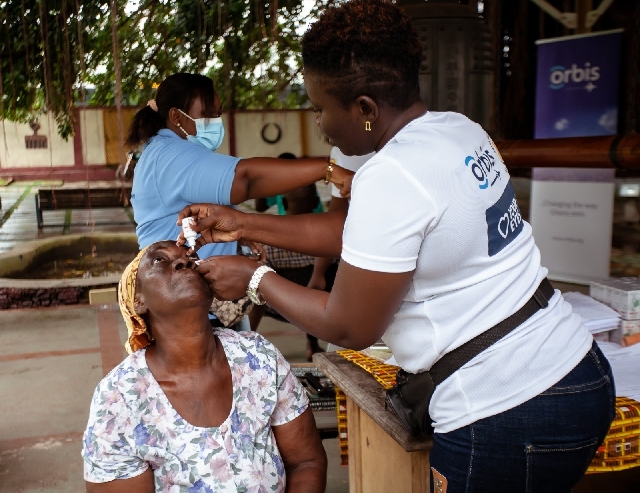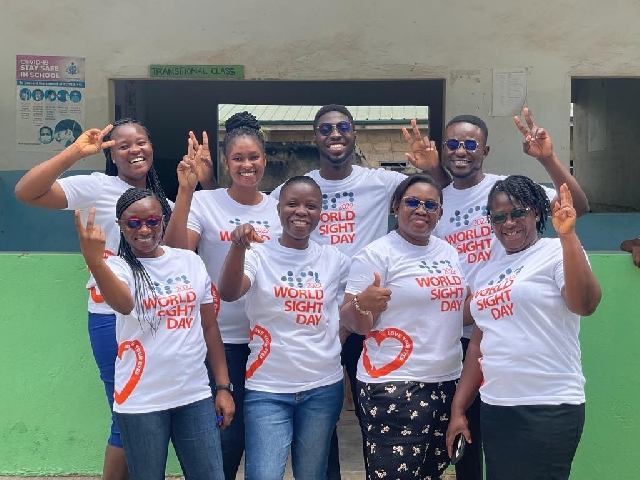More women and girls go blind than men and boys
 Blindness and various forms of vision loss contribute to a great cause of morbidity and disability globally
Blindness and various forms of vision loss contribute to a great cause of morbidity and disability globally
Breaking the Gendered Barrier to Eye Health: Addressing Disparities for Women and Girls
Blindness and various forms of vision loss contribute to a great cause of morbidity and disability globally.
Out of the 1.1 million people worldwide living with vision loss, including blindness due to lack of eye care services, 55% are women and girls This accounts for 112 million more women than men experiencing vision loss, including blindness. Women are 12% more likely to have vision loss than men (VLEG/GBD 2020 model). According to a 2018 report from the Ghana Health Service, eye problems were among the top 10 reasons why people visited a health facility in 2018 in Ghana. The Ghana Blindness and Visual Impairment Study (2015) found women accounting for 54.8% blindness in Ghana. These statistics highlight a gender disparity in visual impairment and blindness, with similar trends both globally and in Ghana, where various eye conditions are frequently reported in health facilities. For Orbis International’s mission of p[preventing avoidable blindness underscores the point that Blindness is a Gender Issue.
Gender encompasses social and cultural distinctions between men and women, encompassing masculinity, femininity, and associated roles and responsibilities. It is however influenced by cultural, societal, and family variations and evolves with time.
The cultural disposition in Ghana largely defines gender roles that are clear and distinct. While women and girls are primarily involved in the greater portion of household activities such as cooking, sweeping, washing, cleaning, and taking care of children, with boys and girls lending some form of assistance, men tend to be primarily involved with more income generating activities like farming, masonry, welding, and carpentry. These defined traditional roles between men and women have seen some dynamism in recent years, with women engaging in income generating such as petty trading, selling food, hairdressing, and tailoring to complement their male counterparts, and men taking up supporting roles in otherwise traditional women’s roles like household chores and childcare.
The unique division of labor between men, women, boys, and girls in the performance of household and economic activities exposes them to different levels of risk with regards to eye health.

Men face occupational hazards from their economic or income generating activities, including dust and wood particles from masonry and carpentry, and agrochemicals entering their eyes from farming. Women on the other hand are at high risk of trauma related eye injuries such as heat, smoke, hot water, and oil splashing on their face resulting from accidents in the performance of household chores. .
In Ghanaian households. women often require permission from their husbands to access general health care, including eye care services. Additionally, men are the final decision makers when it comes to eye related surgery of their children. This can hinder timely access to eye care, placing women, boys, and girls at risk of vision impairment and avoidable blindness. One poignant example of this is a case from Kunsu Dotiem community of the Ahafo Ano Southwest district of the Ashanti region, Ghana. Ama Dotiem (not her real name), 28-year-old mother of 3 was unable to give her consent for 2 of her children aged 11 (girl) and 8 (boy) to receive free surgery to correct their congenital cataract because her husband was unavailable to provide the needed concurrence. As her husband had the final say on care, the children eventually missed the opportunity to have a sight saving surgery and still live with the condition. The need to seek permission and seek financial support before attending eye care does not only put women at risk of vision impairment and avoidable blindness but also boys and girls.
At the community level, decisions regarding health issues, including eye care, are predominantly made by men, despite women experiencing the primary health challenges.
Though financial capabilities, access to health care, long wait time for health care services and limited number of specialists prove to be major barriers for both men and women, spousal consent and support for childcare is a major factor and barrier that affects women exclusively.
Overcoming barriers to accessing eye health care services requires subsidized or free of charge community-based primary eye care services, to overcome proximity and financial barriers. National health insurance coverage for comprehensive eye care is crucial. For women, there is the need for additional support to enable them to access eye care, key among them being support for childcare to allow women to travel and be consistent with their review appointments. A Gender analysis conducted by Orbis found that though more women access eye care services than men, lack of support for childcare is found as the main reason men complete their referrals more than women. Financial independence empowers women to prioritize their health needs.
To achieve the 2030 agenda for Universal Health Coverage and combat vision impairment and avoidable blindness, special support for women is essential. This includes active involvement of male partners in healthcare decisions, integrating women into decision-making processes, promoting women's financial independence, and improving access to eye health services at the policy level.
All individuals, regardless of age or gender, must be included in efforts to ensure healthy lives, including eye health and well-being for all.
Invest in Women: Accelerate Progress
Source: Orbis International, Ghana
Trending Features

Ghana: 68 Years of nationhood sailing through the turbulent times
13:29
Ghana Gold Board(GoldBod) is a very serious error in Judgement
07:28
Review of the 1992 Constitution, too late or too early?
14:40
Kwesi Pratt NOT fit to unloose the shoes of Dr. J. B. Danquah
03:42
Full text of Mahama's maiden budget
10:55
Understanding kidney health: The importance of early detection and prevention
11:23




